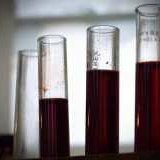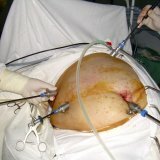Determination of plasma toxicity

This indicator is significantly influenced by such factors as:
- Hereditary;
- Concomitant drug therapy.
- Differences in the functions of the kidneys, heart, liver.
Determination of plasma toxicity due to the use of antiarrhythmic drugs is a valuable reference in the appointment of individual initial therapy, and further regulating the dosage of these drugs.
In addition to these factors, the different pharmacological conditions can affect the pharmacokinetics of some drugs( propranolol and lidocaine) in case of congestive heart failure. Chronic treatment( dopranolol and novocainamide) leads to the accumulation of active metabolites, which in turn can make it difficult to study the toxicity of blood plasma.
Thus, the determination of toxicity, the level of which in plasma can be established when taking a certain dose of the drug, is an important stage not only in determining the strategy for future treatment, but also for a rational evaluation of the effectiveness of antiarrhythmic drugs.
Symptoms of malignant arrhythmias can be successfully controlled with the help of widely used antiarrhythmic drugs. But their use is often fraught with various inconveniences. First of all, the limitations are related to the toxicity of the drugs.
Since the effectiveness of antiarrhythmic drug therapy is directly related to their plasma concentration, treatment should be organized so that the drug content is above the minimum, but below the amount causing various side effects.
The threshold that separates the effective concentration of antiarrhythmic drug from its toxic dosage is low enough. This is the reason for the importance of measuring the toxicity of plasma and the knowledge of the pharmacokinetic definitions by which this threshold is determined and treatment is individualized.
The concentration of a drug injected into the body at any given time can be determined by two processes:
- Distribution.
- Elimination.
Evaluation evaluation.
Evaluation of elimination is carried out by measuring the clearance, defined as the volume of plasma cleared from the drug per unit time. Thus, the drug is removed in direct proportion to its concentration. Consequently, a decrease in this concentration may lead to a progressive decrease in the amount of the drug that is eliminated at any given time.
The semi-elimination period determines the time that is necessary to ensure that the level of the drug in the plasma is reduced by half from the initial level, that is, after which in the body it will remain fifty percent. After it has elapsed, the half-elimination period is recalculated in a new way. Thus, the entire preparation is elaminated after five periods.
It is not possible to determine the toxicity at a sufficiently precise level immediately after the administration of the drug. To achieve an equilibrium level of its concentration in the plasma, a certain time is necessary. The semi-elimination period, in addition to reflecting the rate of decrease in concentration, also shows the rate at which the equilibrium state approaches during continuous infusion. It should be noted here that an increase in the rate of infusion does not affect the time that is spent to achieve an equilibrium state, but increases the concentration of the drug.
Evaluation of distribution.
The distribution and clearance of antiarrhythmic drugs in patients and healthy people are determined by several factors:
- Activity, with which the main removal processes( internal clearance) take place.
- Blood flow through body part or organ.
- Binding of the drug in tissues and blood.
In a practically healthy person, each of these processes is influenced by environmental factors and constitutional factors. In addition, the presence of liver disease and renal or( and) heart failure is important. As a consequence, the concentration of the drug in the plasma varies, as a rule, within a fairly wide range( ten to twenty times), with the same dose given to different patients.
Do not forget that the concomitant drug therapy affects the factors responsible for the concentration of the drug in the plasma. Of particular importance are the individual congenital or acquired features of the human body.
Such as:
- Age of the patient.
- Harmful habits, such as smoking.
- Degree of suction.
But the influence of all these factors can be determined only on the basis of knowledge of the physiological disorders caused by the disease and the mechanism that is responsible for the spread of the drug. What is impossible without constant monitoring of plasma and toxicity of its components. Only having such information, it is possible to choose the right treatment strategy and determine the dosage regimen that will meet the individual needs and specific needs of the patient. The most careful observation of the concentration level of the drug in the plasma is one of the principles on which the use of antiarrhythmic drugs is based today.
In addition, the importance of pharmacokinetic principles is now universally recognized as one of the main benchmarks in optimizing drug therapy. Therefore, measuring the concentration of the drug and, consequently, the toxicity of the plasma, is the main component of the first clinical trials of new drugs.



